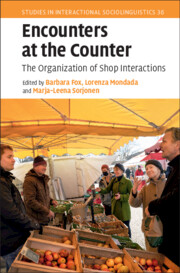Book contents
- Encounters at the Counter
- Studies in Interactional Sociolinguistics
- Encounters at the Counter
- Copyright page
- Contents
- Contributors
- 1 Encounters at the Counter
- 2 Approaching the Counter at the Supermarket
- 3 Customers’ Inquiries about Products
- 4 Offering a Taste in Gourmet Food Shops
- 5 Embodied Trajectories of Actions in Shop Encounters
- 6 Unpacking Packing
- 7 The Request-Return Sequence
- 8 Moving Money
- Appendix Transcription Conventions
- Index
- References
4 - Offering a Taste in Gourmet Food Shops
Small Gifts in an Economy of Sale
Published online by Cambridge University Press: 19 January 2023
- Encounters at the Counter
- Studies in Interactional Sociolinguistics
- Encounters at the Counter
- Copyright page
- Contents
- Contributors
- 1 Encounters at the Counter
- 2 Approaching the Counter at the Supermarket
- 3 Customers’ Inquiries about Products
- 4 Offering a Taste in Gourmet Food Shops
- 5 Embodied Trajectories of Actions in Shop Encounters
- 6 Unpacking Packing
- 7 The Request-Return Sequence
- 8 Moving Money
- Appendix Transcription Conventions
- Index
- References
Summary
This chapter examines sequences of offers by sellers in gourmet shops, video documented in a dozen cities across Europe, focusing on offers of a taste of cheese. Such offers to taste are shown to occur in two types of sequential contexts. They are made when a customer has expressed interest in a product but displays some hesitation in deciding whether to purchase it or not. Such offers to taste pursue sale of the cheese; they are not simple small gifts. Participants orient to this character of the offers by treating them as providing assistance in decision making. On the other hand, if the offer is made sequentially too late or too early, it is rejected, underlining the pursuit of sale at work in an offer of a taste. A contrasting environment of offers is also examined. In these cases, a plate of small pre-cut pieces of cheese are on the counter for anyone to try. The offers are typically accepted by the customer but without leading to buying. This enriches our understanding of the preference organization of offers and requests, and the relationships between benefactor/beneficiary, further supporting the relationship between the offer and the pursuit of the offerer’s interests.
- Type
- Chapter
- Information
- Encounters at the CounterThe Organization of Shop Interactions, pp. 109 - 143Publisher: Cambridge University PressPrint publication year: 2023
References
- 1
- Cited by

